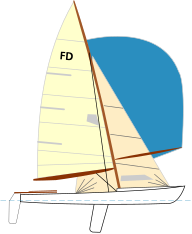Flying Dutchman
| Notation | |
|---|---|

|
|
| Boat dimensions | |
| Length above : | 6.06 m |
| Width above sea level : | 1.78 m |
| Draft : | 1.12 m |
| Weight (ready to sail): | 165 kg trunk 130 kg |
| Sail area | |
| Sail area close to the wind : | 18.6 m² |
| Mainsail : | 10.2 m² |
| Genoa : | 8.4 m² |
| Spinnaker : | 21 m² |
| Others | |
| Rigging type: | Sloop |
| Yardstick number : | 94 |
| Class : | international open class rules, Olympic from 1960 to 1992 |
The Flying Dutchman is a two-man, one-design regatta dinghy .
history
The first design was made in 1951 in the Netherlands by Conrad Gülcher and Uus van Essen. The design was similar to the 15-square-meter touring dinghy and the Flying Fifteen .
In 1952, the then President of IYRU (today World Sailing ) Sir Peter Scott named the prototype "Flying Dutchman". Shortly afterwards, comparative regattas with many different boats (including Hornet , Sharpie , Caenton and Thistle) took place, which the Flying Dutchman won. That was the hour of birth of the Flying Dutchman, and the national and international class organizations began to establish themselves. In the sixties there were fleets in Europe, North America, South Africa, Australia, New Zealand, Venezuela, Argentina and Thailand.
Many technical achievements were developed in the Flying Dutchman. Among other things, the sail window, spinnaker bag, endless harness and the rake. With its versatile trim options and the immense sail area in relation to its weight, the Flying Dutchman is a fast-paced, but demanding dinghy, which requires a lot of skill to master. Even today, almost 60 years after its development, it is considered to be the fastest conventional dinghy.
In 1960, the Flying Dutchman replaced the Sharpie at the Olympic Games and remained Olympic until 1992. But the loss of Olympic status did not mean the end of the boat class. Even today there are large fleets in Europe and North America, among others.
Since 2005 the Flying Dutchman can also be sailed with a mast made of carbon fiber reinforced plastic .
Famous Flying Dutchman sailors
One of the famous Flying Dutchman sailors is Rodney Pattison , who won Olympic gold in 1968 and 1972 and Olympic silver in 1976, was world champion three times in a row from 1969 to 1971 and six times European champion from 1968 to 1975. The brothers Jörg and Eckart Diesch won eight medals at world championships from 1975 to 1986 and Olympic gold in 1976. Her cousin Albert "Alba" Batzill was four times world champion from 1978 to 1989 and won a total of seven medals at Flying Dutchman World Championships and three bronze medals at European Championships (1975, 1988, 1991). The Dane Jørgen Bojsen-Møller sailed Olympic gold in 1988 and Olympic bronze four years later; Between 1988 and 1993 and 2001 and 2007 Bojsen-Møller won six world championship titles and in 1979, 2003, 2006 and 2007 - d. H. 28 years after his first title win - four European championship titles.




